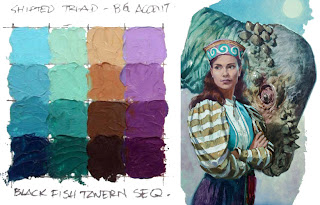Color and Light
Chapter 7: Premixing
Mixing Color Strings
Color string: a group of prepared paint blobs of a given hue mixed with a palette knife in a set of steps from light to dark values.
*This saves time when you're painting from observation.
Advantages of Premixing:
1. Premixing uses less palette surface area than does free mixing.
2. You can premix generous batches with a palette knife instead of using a brush.
3. Premixing saves time in the long run.

Gamut Mapping
Gamut: the entire group of possible colors for a given painting.
Good color comes from not only what you put in a composition, but what you leave out.
Polygon superimposed over the color wheel represents the gamut of a particular painting.

Creating Gamut Masks
Create a "universal" gamut shape you can slide around on top of a color wheel to create new color palettes.
Advantages:
1. You're not limited to the haphazard choices of pigment-based limited palettes.
2. By rotating the gamut mask around the color wheel, you can invent and preview new color schemes you may not have thought of otherwise.
3. When taken as a whole, the colors within the gamut with their subjective primaries and neutrals feel sufficient for a complete color scheme, even though a lot has been left out.
Shapes of Color Schemes
Color gamuts can range from using only one side of the color wheel to spanning a wide range of colors.
Most common shape is a triangle. It usually includes a dominant full-intensity hue and two subordinate, lower-chroma colors to balance it.
Can range from narrow to broad.
Narrow: primary
Broad: triad - moody and subjective
Mood and accent: Most of the picture lies in one color environment with just one accent area from across the wheel and no intermediate mixture.
Mixing a Controlled Gamut
Once you choose a gamut, you can mix strings of the colors defined by it.
These strings of color become the source colors for the entire painting.

Color Scripting
In a sequential art form, such as a graphic novel, illustrated book, or animated film, no color scheme stands alone. Every page, panel, or frame must be seen in relation to the one that precedes and follows it.

No comments:
Post a Comment